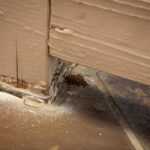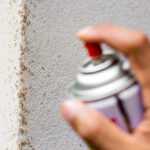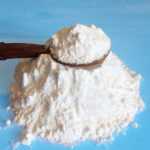Understanding Moisture Ants
Moisture ants are a type of ant that thrives in damp environments, feeding on sweet substances and honeydew produced by aphids. These ants are often mistaken for carpenter ants due to their similar appearance, but they can be identified by their yellowish-brown color and translucent abdomen. Moisture ants are particularly attracted to areas with high humidity and moisture, making them a common pest in homes and buildings, especially in the Pacific Northwest. Their preference for damp environments means they are frequently found in places like basements, crawl spaces, and areas with water-damaged wood.
Moisture Ant Identification and Habitat
Moisture ants get their name from their love of living in damp humid environments. Often homeowners become aware that they have a moisture ant infestation during a remodel as these ants love to live in damp humid spots behind walls, or by finding a frothy like substance that is being pushed out between wall seams.
Moisture ants are common here in Oregon and Washington due to our abundance of moisture and our relatively temperate climate which creates moisture and humid rich environments for these ants to thrive in. Outdoors, moisture ants prefer moisture rich soil and rotting damp wood. Moisture ant colonies often nest in wet wood, which provides the damp environment they need to thrive. It is also not uncommon for these ants to build colonies next to home foundations, which can introduce these pests to your home leading to infestations if your home has too much humidity or has rotted moist wood. These moisture ant colonies can be particularly problematic if they establish themselves in wet wood within the structure of your home.
Moisture Ants or Carpenter Ants?
Moisture ants can sometimes be confused with carpenter ants. Many homeowners misidentify them based upon these ants building their homes in rotted or dead wood. Often moisture ants are called “yellow ants” due to their yellow tinted color, which is different from carpenter ants colors of black or brown. Moisture ants are largely nuisance pests, indicating underlying moisture issues in structures rather than causing direct damage like carpenter ants.
Dealing with a moisture ant infestation can be a time-consuming and sometimes expensive process. To get rid of these ants, you will need to remove the reason they came to your home in the first place. Consulting with an experienced pest control company that is trained in ant identification can help to ensure that you have a moisture ant problem and not a carpenter ant infestation.
Life Cycle and Behavior
Moisture ants undergo a complete metamorphosis, starting from eggs, progressing through larval and pupal stages, and finally emerging as adults. In suitable conditions, their colonies can grow rapidly, with a single queen responsible for laying eggs and producing new ants. These social creatures live in colonies with a complex social hierarchy, where each ant has a specific role. Moisture ants are known to tend aphids for their honeydew, a sweet substance they feed on. Additionally, they can scavenge for dead insects or other protein sources, showcasing their adaptability in finding food.
Dangers of Moisture Ants
While moisture ants themselves are not dangerous, their presence can indicate potentially damaging moisture issues in your property. These ants can infest wet, water-damaged wood, and their tunneling can cause wood to decay at a faster rate, leading to structural damage. The presence of moisture ants can also be a sign of other problems, such as plumbing leaks or infestations by other wood-damaging pests like carpenter ants or termites. Addressing the underlying moisture issues is crucial to prevent further damage and potential infestations.
Getting rid of moisture ant infestation
The remedy starts with identifying where the moisture in your home is coming from. Here in Portland and Vancouver leaking roofs, basements, plumbing and foundation / crawl space drainage problems can all lead to introducing moisture and humidity to your home. Dirt and overgrown shrubs that come into contact with your homes wood is also another common problem that accelerates wood decay as well as introduces moisture to your home. Addressing issues like decaying wood is crucial, as it can attract moisture ants and indicate underlying water damage in your home. Getting rid of excessive moisture in your home is the first step to ridding your home of a moisture ant infestation.
Once the moisture problem has been rectified in your home, finding the areas the moisture ants have colonized and in some cases exterminating these areas may the next step. Hiring an experienced pest control company can help you identify areas infested with moisture ants. Chemical Control of Moisture AntsThese ants are ecological indicators of a moisture problem. To eliminate them only requires changing the environment (eliminating moisture). Chemical control is rarely advised unless they are nesting near or under the house and begin to be a nuisance. If this is the case, then chemical control may become necessary. There are a number of products on the market that homeowners can obtain to treat the nest site. If you cannot find the nest or if it is located in an inaccessible place (such as a narrow crawl space), you may wish to consult a pest management professional.Finally, once the moisture ants have been safely removed, the rotted wood must be replaced to ensure there is no re-infestation in the future.Source: Washington State University
Moisture Ant Treatment & Extermination
Because treatment for moisture ants and carpenter ants is so different, it is wise to hire a reputable pest control company to ensure you know what you’re dealing with. Knowing what you’re up against, as well as having a sound plan to deal with these unwelcome pests, will make sure you get rid of these ants the first time, and for good. Identifying and treating moisture ant colonies is essential to ensure complete extermination and prevent re-infestation. Call PURCOR today for a free quote!
Preventing Future Infestations
Preventing moisture ants requires maintaining a dry environment. Regularly inspect for water leaks, ensure adequate ventilation in attics and crawl spaces, and keep gutters and downspouts clear to prevent water accumulation. Fix any leaks around your home or business, and repair any water-damaged, moist, or rotting wood within the structure of your property. Eliminating potential nesting areas for moisture ants is essential, as is keeping food properly sealed and contained to prevent them from feeding on sweets and sugary foods. By taking these preventive measures, you can significantly reduce the risk of a moisture ant infestation.
A moisture ant infestation occurs when moisture ants infest a home or building, often in areas with high humidity and moisture.
Moisture ants can be identified by their yellowish-brown color, translucent abdomen, and small size. They are often mistaken for carpenter ants, but can be distinguished by their size and color.
While moisture ants themselves are not dangerous, their presence can indicate potentially damaging moisture issues in your property.
To get rid of moisture ants, fix the underlying problem that allows water into the area, replace all of the rotted wood to eliminate the habitat for the ants, and consider insecticide treatment from a professional ant exterminator.
Preventing moisture ants requires maintaining a dry environment, regularly inspecting for water leaks, ensuring adequate ventilation, and keeping gutters and downspouts clear.
Moisture ants are attracted to damp environments and feed on honeydew produced by aphids, while sugar ants are attracted to sweet foods and can invade your kitchen.
Yes, moisture ants can be a sign of other problems, including plumbing leaks or other wood-damaging pests like carpenter ants or termites.
You can find a local pest control professional by searching online or checking with your local pest management association for recommendations.
"*" indicates required fields
"*" indicates required fields




